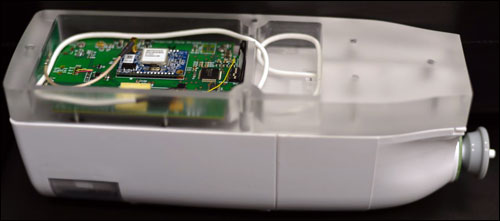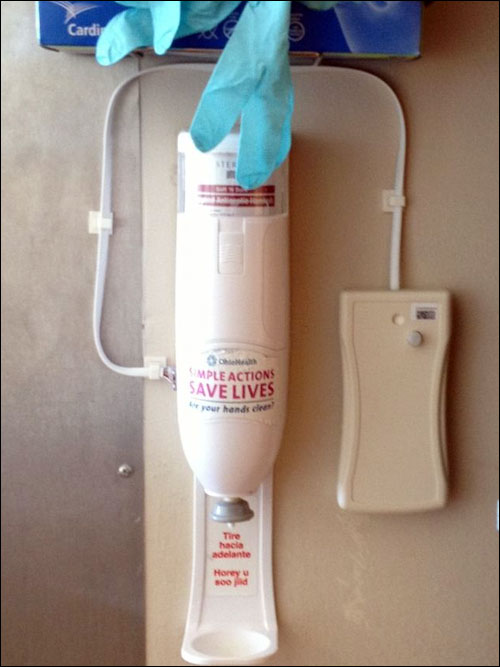Hand-hygiene compliance has become something of a competitive sport at OhioHealth’s Riverside Methodist Hospital, thanks to the installation of a radio frequency identification system that monitors which staff members wash their hands and how consistently they do so, and allows them to view their own results against those of their coworkers. The system, provided by IBM Research, allows nurse managers to identify whether a particular worker has or has not complied with hand-hygiene requirements by washing hands upon entering and leaving a patient’s room.
David Rutherford, the nurse manager at the hospital’s trauma and intermediate care unit, says he has posted a list of the rates at which health-care personnel washed their hands as expected, along with the unique ID number of each staff member’s RFID badge, enabling workers to compare their own compliance rates against those of their colleagues. Since the system was taken live as a yearlong pilot project in March 2013, Riverside Methodist—located in Columbus—has reported a compliance rate of approximately 94 percent. That contrasts with the national average of only 50 percent.

Riverside Methodist set up the trial on two separate floors, each with patient rooms that health-care personnel enter and exit regularly. One floor is dedicated to trauma and the intensive-care unit (ICU), while the other is designated for medical telemetry. Each floor houses about 33 patients.
According to Joint Commission guidelines, health-care workers should always wash their hands upon entering a patient’s room, and again as they leave. This not only protects patients from exposure to any bacteria and viruses that could be on an employee’s hands, but also protects that worker from any contagious infection with which he or she might come in contact while treating a patient.
Typically, hand-washing is carried out at stations that dispense sanitizing soap. Whether personnel actually wash their hands as often as recommended can be difficult to measure, however. OhioHealth’s goal was to install a system to provide that measurement on a pilot basis, and to then expand the solution’s use if it was found to be effective.
With the solution, the hospital has installed about 100 battery-powered wireless RFID sensors on each of the two floors. Specifically, IBM Research developed and installed what it calls low-power mote technology (LMT) sensors, consisting of 433 MHz RFID readers and 2.4 GHz motes that act as network transmitters. Each of the hospital’s existing hand-washing stations was wired to an RFID sensor and mote, says Sergio Bermudez, IBM’s team lead, most installed at room entrances, with others deployed in hallways or at elevators. The motes form a mesh network on each floor, which forwards information to a gateway connected to a computer that transmits the data to IBM Research’s server.
Approximately 250 staff members were each provided with an active 433 MHz RFID tag (also from IBM Research) that beacons a unique ID number linked to that individual’s identity, as well as the team or shift on which he or she works. Upon entering a patient room, the participating health-care worker comes within the 5-meter (16.4-foot) read range of a hand-washing station, which captures that individual’s RFID badge ID. The software residing on IBM Research’s server then expects the staff member to stop at the hand-washing station and press the soap dispenser. Once the dispenser has been depressed, it informs its mote device of this action, and that information is forwarded to IBM Research’s server via the mesh network and gateway.
Although the badge can be read from a distance of 5 meters, the rooms are large enough that once a worker enters a room to visit a patient, the badge ceases to be read. When the staff member begins moving back toward the door, the badge’s tag is again read, and the system presumes that the worker is now leaving the patient room and must wash his or her hands again. That action is also saved in the software. IBM Research’s software on its hosted server tracks employees’ ID numbers but not their names. However, the hospital itself maintains a record of which worker is associated with which serial number.
When the technology for the pilot was first installed, IBM Research provided the hospital with weekly or daily reports indicating the rate of compliance for each ID number, as well as for the groups in which the corresponding individual worked. However, the software has since been modified so that managers can access that data themselves every 15 minutes, enabling the managers to then link an ID number to a particular individual and thereby view how that person has been performing while on duty. “As a manager, I want to be able to give a person feedback,” Rutherford says. Rather than knowing generic results from a group after a certain period of time, he prefers to access data while the workday is still underway. “I can take someone aside and thank them for their high compliance,” he explains, “or I can talk to someone if their rate is low.”

When Rutherford began posting a list of ID numbers and compliance rates, he says, staff members became interested in viewing their own results and ascertaining how they measure up against coworkers. As result, those with low compliance rates have begun to increase their hand-washing behavior in an effort to raise their rates. In fact, Rutherford notes that he, too, wears an RFID badge and often checks his own compliance rates to determine how he is doing.
Ultimately, Rutherford notes, it is impossible to attribute a change in the infection rate to one specific behavior, such as hand hygiene. However, he says, the technology “increases awareness, which also increases compliance,” and that should “contribute to a reduction in infection rates.”
The next step could be to expand the RFID technology’s deployment to additional floors, sometime in 2014. Rutherford says there are not yet any specific plans for such an expansion, so in the meantime, the hospital will continue to evaluate the current deployment’s performance.
IBM Research has been designing sensor-based wireless communication systems for several years, Bermudez says. These solutions have been installed at museums, for example, to track temperature or moisture levels wirelessly.


